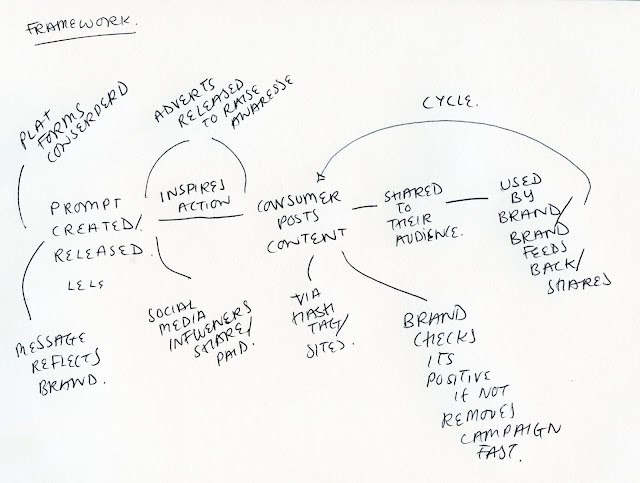Client Choice/Restrictions
SOCIAL MEDIA TARGET AUDIENCE RESEARCH
16 - 24 year olds, appeal to a younger market
None Gendered
Low disposable income (should be a cheap)
in the UK (available all over the UK)
Share a coke worked well as it's easily photography able/readily available this should follow this ideas.
Must have a social media presence, therefore will be up to date with pop-culture/social media
Will watch little TV and read little magazines (focus needs to be socially based)
Live at home or in their first house, (therefore nothing home based)
Cannot be alcohol or illegal based, due to care of their social presence
After studying a range of successful and non successful social media campaign in comparison a collection of client restrictions and aims that will allow the project to be the most successful have been identified. For research it has been deduced that Social media advertising works the most successfully for brands that fit within these limits, this is due to the audience of social media and how the effective nature of the campaigns is based of the audience driven content. The more content the audience create the more engagement is given to the outcome.
-Easy assessable product (sold at most shops, so the audience can access it without a car)
-Cheap product (due to low disposable income of social media users)
-Appeal or is used by an audience of 16-25 year olds
- Non Alcoholic or Tabacco products ( as many social media users are 16-17, not able to drink legally)
-Non controversial product (NameAHorse backlash, due to issue wit horse racing)
-Lighthearted, informal tone (Many successful social media campaigns have humorous aspects, follows the tone of the platforms as to integrate)
-item most household will own/use
-Don't already have a good social media presence/campaign (needs to fulfil a need)
-Needs to be a well known, or common brand, No supermarket brands (as to be stocked everywhere)
CURRENT IDEAS
-Smarties
-Skittles
-Heinz
-Yorkshire Tea / PG tips
-Hubba Bubba
-Extra Gum
-Red Bull
-Fanta
-Oreos
-Walkers/Crisps
FEEDBACK
BRANDS ANALYSIS
Before picking a brand the current ideas have been examined as to highlighted aspects given via research for each of the Client. This is as to ensure the Brand selected will be as suitable for social media advertising as possible.
FEEDBACK
-'find a few ideas for the brands, then it's easy to see which would work socially'
-'Nike is already very social, don't use them'
-'Some of the brands target a too young audience, social media is used by people over 18 heavily as well'
-'I agree, the brand needs to be slightly more serious, i wouldn't want to share about hubba bubba as it seems to child like'
- 'the campaign needs to be fun, social media is not serious and i don't want to go online and see a serious brand'
-'Skittles, Heniz and Yorkshire Tea seem the best to me'
-'I think it more about the campaign than the brand, if the campaign works and people share that it's important that which client you pick'
-'Chuppa, Chupps could be a good client'
After the feedback it was clear that a version of ideas need to be considered, as the client choice depends on if the idea would work. Overall people felt like if the campaign had a strong talking point/start people would share it for any of these brands.
Initial Ideas for the brands
aims taken from essay points -
HAS TO CREATE A TWO WAY CONVERSATION
HAS TO WORK OVER THE DIFFERENT MEDIAS
GIVE THE AUDIENCE SOMETHING TO SHARE/START THE CONVERSTATION
USE SOCIAL MEDIA TO REACH A LARGE AUDIENCE
INTERGRATE WITH THE PLATFORM/IT'S BENEFITS
GIVES THE POWER TO THE CONSUMER
ALLOWS THE BRAND CONTROL THE CONVERSTATION/NO BACKLASH
FLUMPS // SHAPE IS THE SELLING POINT-
1)
What A Flump create a campaign that drives fails to be described at 'flumps', the audience shares mistakes/accidents with the hashtag - WhatAFlump
2)
Flump Mustache Idea Audience takes photo using flumps as fake mustaches, TV and broadcasting adds would be a range of famous people using flumps as these (links to powerful other theory)
3)
Flump Feet Audience measures them selfs using flumps then shares the imagery and data, online challenge, Traditional adverts showing how to do this/promoting the act
HUBBA BUBBA// COLOUR IS THE SELLING POINT-
1)
Hubba Bubba Match, can the audience find anything he same colour as the gum strip? they would then post imagery related to this theme over social media including the hashtag HubbaBubbaMatch. Social media challenge, playing on the brands unique colour scheme and bright nature, allows the audience to share their product as well as relating and online challenge/game targeting the audience playful nature.
2)
Hubba Bubba Tongue, campaign to get the audience to share the image of the tongue after using the product, would encourage the silliest picture, images then would be used as to form the broadcasting/print ad campaign
3)
Hubba Bubba Lipstick, this would give out a free lipstick or lipstick relating to the brand colours scheme and gum colour, the audience could then upload picture of this to social media. Also would have social media stickers, filters ect available so the lipstick could be applied digital (integrated with the media benefits)
SKITTLES // COLOUR IS THE SELLING POINT
1)
Dress As A Skittle, this idea would be to encourage people to go out/fancy dress in the skittle colours. Each person would wear an outfit consisting of one colour pieces, the group together would show all he skittle colours. Then the images shared on social media would include the hashtag, DressAsASkittle, links to how the audience use the media to share selfies.
2)
Skittles Eyeshadow, similar to the hubba bubba idea, this would give out a free eyeshadow relating to the brand colours scheme and sweet colours, the audience could then upload picture of this to social media. Also would have social media stickers, filters ect available so the eyeshadow could be applied digital (integrated with the media benefits)
3)
Skittles Desk Games, This idea would use the inside packaging of skittles as to create a mini game field, printing the range of marks on to the inside then this can be used to play the gam by the audience, substituting the skittles as the balls. the audience could campaign for the new game, and also show the imagery/scores the game online with the hashtag. Issue with this is a more packaging driven campaign.
YORKSHIRE TEA // YORKSHIRE PROUD NATURE
1)
Yorkshire Insult, each pack of tea comes with a traditional Yorkshire insult badge. The audience can submit typically yorkshire insults online via social media, then the top ones get made into the badges and sent out.
2)
Yorkshire Translation Cards/Books, Yorkshire tea would put together a translation book explaining common, funny or unique Yorkshire phrases. People would be promoted to share their favourite Yorkshire phrase socially, then the mot popular would be added to the book or onto translation cards.
3)
Proper Tea, how to make a nice cup of tea is a common debate, this would use this as to allow people to share socially how they make their tea and how they think it should be done. This would spark an online debate around the issue with Yorkshire tea at it's heart. Then the adverts would show a range of how celebrities like their tea, (links to powerful other theory)
4)
It ain't good if it ain't Yorkshire, the phrase would be in reference to the tea but the campaign would relate it to general life. Many people think Yorkshire version of things are better than others, like muffins, this would create a online conversation where people discuss the best aspect of Yorkshire culture sharing their views. New twitter word limit allows the long hashtag to work. People are very proud of Yorkshire, this would give them social platform to show this but sharing the brand also.
EXTRA GUM // WRAPPER
1)
Wrapper Throwing Contest, online challenge, how far can the consumer throw the wrapper of the gum
2)
Other uses for Gum, would prompt the audience to share their other uses for gum, silly and useful. The other uses would then form the adverts, they would be made and photographed/recored.
CHUPPA CHUPPAS
1) Chuppa Chupp Chups, This would be a campaign that drove the audience to use social media to draw faces or limps on to their lollies, then share these images or stories. The packaging would express the idea, giving the lolly a head the the user could edit this using the camera effects available on Facebook, Instagram and snapchat. The audience would then share this to the audience, the best could be used to form the TV adverts ect.
2)Chuck a Chuppa Chupp, this campaign would be about giving a lolly to a friend as a little gift, could use packaging design related to the seasons/popculture. Also this campaign could be based around when someone buys one, they give one to child somewhere to help them.
FEEDBACK-
After creating a range of ideas for the current clients feedback was collected, this as to see which client idea the audience preferred and also to see if their was any client idea the audience felt was most suitable for the mediums/the most likely to be shared or effective.
'Yorkshire tea ideas seems the least childlike, like the audience is young but not children young who would buy chuppa chupps and flumps'
'Extra Gum has done a good campaign, based around the wrapped, research this more?'
'The chuppa chupp idea of giving a kids one is bad, as why give a kid sugar? give him something better, also too similar to toms'
'Some of the idea seems to complex, social media advertising need to be simple, the hashtag needs to say it all'
'I like the tea judge thing, try a pantone shade tea thing?, where people can judge cups of tea based off colour' Alice Morris
'Yorkshire insult idea is sick, i'd do that, i'd also like the badge'
'Yorkshire tea seems a good client, because it's got a casual tone of voice so it's fun but it's not too young like some of the others'
'The skittles dress thing could be good, but it's takes a lot of audience participation and effort, wouldn't be shared a lot.the idea should be something anyone can do, easily so it should take that much effort as this will reduce the amount of people that do it'
'People care about Yorkshire culture, and get snobby about it so this could work as to portray Yorkshire'
'I'd rather share something related to tea on Instagram then chewing gum'
Feedback from the ideas seem to heavily back the more adult idea of Yorkshire tea, as it was decided that many of the other client ideas seems t immature to be shared by anyone over 14. Overall the audience asked in the crit seemed to conclude that Tea was a good subject area as young people like it but it doesn't appear too immature on their profiles, they wouldn't be ashamed of sharing this topic or content related to the topic.
Also the feedback highlighted issues with distribution and audience, the brief needs to be easily accessable so it can interacted with by a wider audience. Social media platform benefits should be used to promote this engagement, the projects should take advantage of the benefits of social as to integrate on the sites but also be used further.
Another aspect not considered in depth earlier this crit showed is the outcome needs to be quick or easy to complete. People feedback they only do stuff on social if they can do it quickly or easily as interest time limits are lower on social sites as the user will constantly see other content and get distracted therefore the outcome needs to be easily and quick to share.
CLIENT - YORKSHIRE TEA






















































